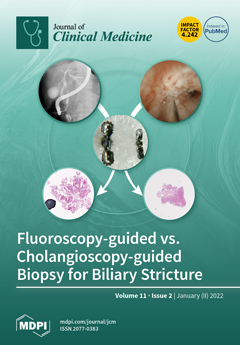Background: We aimed to assess a liposomal fat-soluble vitamin formulation containing vitamin K2 with standard treatment in cystic fibrosis (CF). Methods: A multi-center randomized controlled trial was carried out in 100 pancreatic-insufficient patients with CF. The liposomal formulation contained vitamin A as retinyl palmitate (2667 IU daily) and beta-carotene (1333 IU), D3 (4000 IU), E (150 IU), K1 (2 mg), and K2 as menaquinone-7 (400 µg). It was compared with the standard vitamin preparations in the closest possible doses (2500 IU, 1428 IU, 4000 IU, 150 IU, 2.14 mg, respectively; no vitamin K2) over 3 months. Results: Forty-two patients finished the trial in the liposomal and 49 in the control group (overall 91 pts: 22.6 ± 7.6 years, 62.6% female, BMI 19.9 ± 2.8 kg/m
2, FEV1% 70% ± 30%). The main outcome was the change of vitamin status in the serum during the study (liposomal vs. standard): all-trans-retinol (+1.48 ± 95.9 vs. −43.1 ± 121.4 ng/mL,
p = 0.054), 25-hydroxyvitamin D3 (+9.7 ± 13.4 vs. +2.0 ± 9.8 ng/mL,
p = 0.004), α-tocopherol (+1.5 ± 2.5 vs. −0.2 ± 1.6 µg/mL,
p < 0.001), %undercarboxylated osteocalcin (−17.2 ± 24.8% vs. −8.3 ± 18.5%,
p = 0.061). The secondary outcome was the vitamin status at the trial end: all-trans-retinol (370.0 ± 116.5 vs. 323.1 ± 100.6 ng/mL,
p = 0.045), 25-hydroxyvitamin D3 (43.2 ± 16.6 vs. 32.7 ± 11.5 ng/mL,
p < 0.001), α-tocopherol (9.0 ± 3.1 vs. 7.7 ± 3.0 µg/mL,
p = 0.037), %undercarboxylated osteocalcin (13.0 ± 11.2% vs. 22.7 ± 22.0%,
p = 0.008). Conclusion: The liposomal fat-soluble vitamin supplement containing vitamin K2 was superior to the standard form in delivering vitamin D3 and E in pancreatic-insufficient patients with CF. The supplement was also more effective in strengthening vitamin K-dependent carboxylation, and could improve vitamin A status.
Full article






